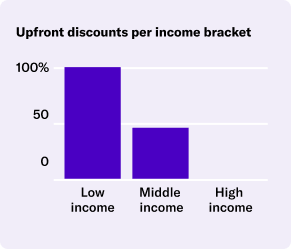Electrification Rebate
Expand each section to see amounts for different households.
Electrification Rebate
Save up to $840
Depending on your income
For low-income households (under 80 percent of Area Median Income), the Electrification Rebates cover 100 percent of your electric/induction stove costs up to $840. For moderate-income households (between 80 percent and 150 percent of Area Median Income), the Electrification Rebates cover 50 percent of your electric/induction stove costs up to $840. The rebates may be implemented differently in each state, so we cannot guarantee final amounts, eligibility, or timeline. And without additional appropriations from Congress, the rebate programs will end once their initial IRA funding is exhausted.
Total Electrification Rebates discounts across all qualified electrification projects are capped at $14,000.
All the details
Expand each section to learn more
How does it work?
The term “electric stove” (or “range” or “cooktop”) includes both traditional electric resistance stoves and modern electric induction stoves. These technologies are quite different, but what matters is that neither burns methane gas inside your home to create heat.
Traditional electric resistance stoves — often with metal coil burners — have been sold for decades, and are what you probably think of when you hear “electric stove.” They operate much like your toaster in that the burner gets hot as electricity passes through a resistance element.
Modern electric induction stoves operate quite differently - energy is transferred directly to the cooking pan through a magnetic field. As a result:
- The cooktop surface doesn’t get very hot, so there’s less chance of getting burned.
- They heat super-fast and can be accurately controlled.
So not only are induction stoves better for the environment than gas stoves, but they work better, too.
How will it save me money?
Induction stoves are more efficient than both gas and electric resistance stoves, and are somewhat cheaper to operate. Because you only use your stove for a few minutes a day, your energy bill savings won’t add up to much every month — but then again, you can’t put a price on the joy of watching a pot of water boil in less than half the time!
Why is it better for the environment?
Neither induction nor electric resistance stoves burn fossil fuels. They also don’t require gas hookups, which often leak methane — a potent greenhouse gas. In fact, recent studies have shown that methane leaking from gas-burning stoves installed in U.S. homes, even when they are turned off, has the same negative impact on the environment as the carbon dioxide emitted from around 500,000 gasoline-powered vehicles.
How is it better for my health?
Induction and electric stoves provide substantial health benefits over gas stoves. Gas stoves burn fossil fuels in an enclosed space, releasing carbon monoxide, nitrogen dioxide, and other pollutants and carcinogens directly into our homes. These pollutants can cause detrimental health outcomes — especially in children and older adults — such as triggering asthma attacks, decreasing overall lung function, and increasing chances of serious respiratory illness. One scary stat (among many): children in homes with gas stoves are 42 percent more likely to experience asthma symptoms than children in homes with electric stoves.
Induction burners also don’t get hot (only the pot or pan does!), so there’s less chance of getting burned. And since they have flat tops, they’re way easier to clean.
Last but not least, induction stoves simply work better than gas stoves. They boil water faster, heat food more consistently, and can be controlled at precise temperatures.



